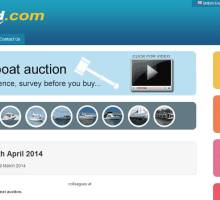
Can you sell a boat at auction?
Is an auction a good place to buy a boat? With the success of eBay and other auction sites, the idea of placing boats for sale in a competative auction envoiroment seems a good one, we could all do with a bit more keen sales activity!
However, the fundamental problem seems to be that of process. Are you really going to purchase an expensive vessel on the fall of a hammer, when you haven’t had the opportunity to thoroughly check either the structural integrity of the boat or, at least if it’s in the water, what the condition of the underwater components are in?
The idea of an auction seems to fit well with the sale of boats as there appears 3 main barriers to sales.
1 Over Valuation..from a seller’s perspective, everyone’s boat is the best boat in the world and therefore asking prices tend to be over the top.
2 No Guide Prices....This is only exacerbated by the fact that no realistic or clear pricing information exists for the value of second hand boats.
3 Perception of Bargains....On the other side of the coin, buyers in the current economic climate really feel that they should be getting an absolute bargain. If you believe half of the things that are printed in the media, the poor boat owners should almost be paying people to take the boats off their hands.
These situational extremes are fundamental in the challenges that surround the sale of used boats in the current marketplace. Buyer and seller have never been further apart and, without any realistic data to refer to, the situation only breeds indecision and inactivity.
The Boatshed Pitch.....(here it comes!)
Another key component of the equation that Boatshed has is the “Customer Behaviour” data. The simple registration system on Boatshed enables the platform to monitor who’s looking at which boat, how many times they look and what other boats they look at.
Traditional auctions have relied on extensive advertising campaigns to notify potential buyers that an auction is happening. However, because BoatBid potentially knows who is interested in any of the vessels put forward to auction, it can use this data to make potential buyers aware. By utilising the Boatshed behavioural data, and bearing in mind that the boat that’s been listed with Boatshed over a three-month period may have anything from 3,000 to 10,000 registered customer views, you can then work out who potentially the interested parties are who should be notified about an auction.
The auction mechanism is all about giving the opportunity for interested parties to attempt to bridge the gap between what the seller would like to achieve and what the purchaser is willing to purchase at. Hence the BoatBid auction has been successful without the need to make a great deal of fuss in terms of marketing.
In regard to the reticence of most buyers to purchase a boat on the fall of a hammer, the BoatBid auction system simply deals with this by offering a survey and/or sea trial as part of the bidding and offer process, meaning that a potential purchaser, should his bid either reach a reserve or be re-negotiated after the auction to a level that the purchaser is willing to accept, can then undertake, having paid a deposit, a survey and sea trial on the vessel. After the survey and sea trial, he is at liberty either to complete the purchase or reject the vessel. Upon rejection, any deposit is refundable.
This simple process in a difficult economic climate is proving to work successfully. For more information, see Boatbid.com.


